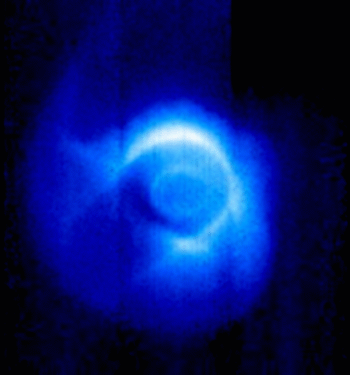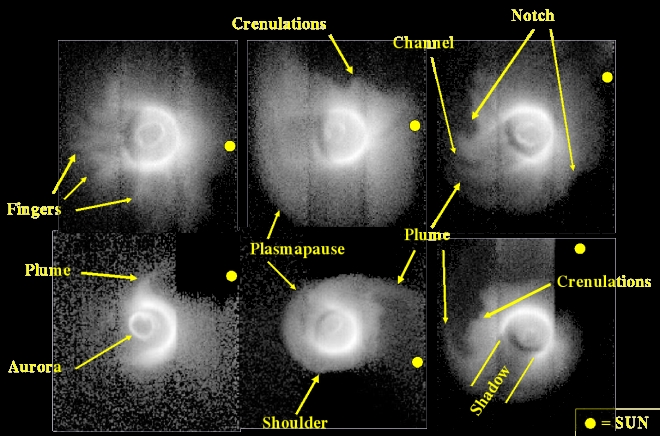
The Plasmasphere We can See!
When the NASA satellite, IMAGE, launched in March 2000, it carried instruments that could measure the plasmasphere and magnetosphere. Scientists analyzed the pictures and videos of the Earth's plasmasphere, and have identified a number of features on it and about it.
A Common Misconception
One such result is that the plasmapshere's corotation lags behind Earth's. Even though the plasmasphere surrounds the Earth, data from a recent NASA satellite, IMAGE, has shown that the plasmasphere DOES NOT corotate with the Earth. Although times vary, the plasmasphere takes 27 hours on average to do a full rotation. It takes Earth 24 hours to do a full rotation. So, the Earth actually spins faster than the plasmasphere on average.
See the plasmasphere rebuilding.

- Plume-
- A tail on the plasmasphere. Caused in part by rotation of the Earth and plasmasphere's dragging rotation.
- Aurora-
- The Aurora Borealis seen on and near the poles of Earth. They are also called the "northern lights" although they are seen on the south pole as well. From space, we see a bright ring above the poles of Earth
- Plasmsapause-
- The "edge" of the plasmasphere. The region at which point plasma denisity drops sharply.
- Fingers-
- Long thin areas around which there are sharply lower plasma densities resulting in a finger-like display.
- Crenulations-
- Sharp spikes, low and high, in plasma denisty often near the edge of the plasmasphere. Edge-like areas of the plasmasphere that look as if someone took a bite out of the plasmasphere or ripped a part of the plasmasphere away.
- Channels-
- Channels are formed when plumes wrap around the main body of the plasmasphere during quieting space weather conditions after a storm. They have the appearance of azimuthally extended and narrow low density regions in the outer plasmasphere.
- Notches-
- Notches are large, low density cavities in the plasmasphere that can extend inward to 2 Earth raddi from the center of the Earth. They can be azimuthally narrow or broad enough to contain an earth-sized volume.
- Shoulder-
- Shoulders are rounded shapes on the outer plasmaspheric boundary or plasmapause that appear to result from transient shielding of the solar wind electric field penetrating into the inner magnetosphere.
- Shadow-
- The shadow shown here does not represent a feature of the plasmasphere. Plasma in the shadow cast by the Earth in sunlight does not scatter sunlight, so it is dark. We can sometimes appear to see plasma where Earth's shadow should be because the plasma above and below the shadow (as viewed by the IMAGE camera) is illuminated.
Web Links
NOAA's Space Weather Prediction Center - Today's Space Weather Updated Every 5-minutes
National Space Weather Program - The U.S. Government and Space Weather
Responsible Official: Dr. David McKenzie
Last Updated: May 27, 2015
